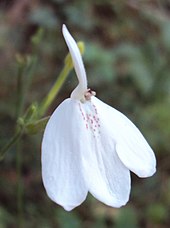Rhenacanthus nasutus (L.)

CLASSIFICATION
| ORDER | : Lamiales |
| FAMILY | : Acanthaceae |
| GENUS | : Rhenacanthus |
| SPECIES | : nasutus |
| BOTANICAL NAME | : Rhenacanthus nasutus (L.) Kurz |
| SYNONYMS | : --- |
| COMMON NAME | : Snake jasmine. |
| TAMIL NAME | : Nagamalli |
| HINDI NAME | : Palakjuhi |
PLANT DESCRIPTION
| HABIT: Native to India, this useful plant is a slender, erect, branched, somewhat hairy shrub 1-2 m in height. |
| LEAVES: The leaves are oblong, 4-10 cm in length, and narrowed and pointed at both ends. INFLORESCENCE: The inflorescence is a spreading, leafy, hairy panicle with the flowers usually in clusters. |
| FLOWERS: The calyx is green, hairy, and about 5 mm long. The corolla-tube is greenish, slender, cylindric, and about 2 cm long. The flowers is 2-lipped; the upper lip is white, erect, oblong or lancelike, 2-toothed at the apex, and about 3 mm in both length and width; and the lower lip is broadly obovate, 1.1-1.3 cm in both measurements, 3-lobed, and white, with a few, minute, brownish dots near the base. |
| FRUIT: The fruit (capsule) is club-shaped and contains 4 seeds. |
MEDICINAL USES
| In India the fresh root and leaves, bruised and mixed with lime juice, are a useful remedy for ringworm and other skin affections. |
| The seeds also are efficacious in ringworm. |
| The root-bark is a remedy for dhobie’s itch. In Sind it is said to possess extraordinary aphrodisiacal powers, the roots boiled in milk being much employed by Hindu practitioners. |
| The roots are believed n some parts of India to be an antidote to the bites of poisonous snakes. |
IMAGES
Print this page

